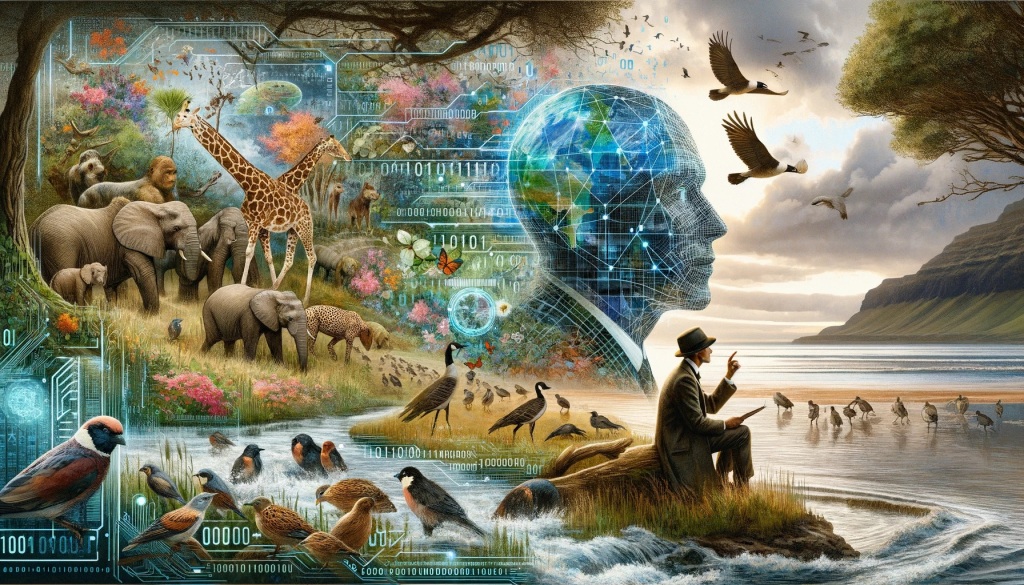As we bring this AI series to a close, it’s intriguing to ponder over AI’s alignment with Maxwell Knight’s lifelong dedication to nature. Knight, an illustrious naturalist and former MI5 spy-handler, devoted his life to the study and conservation of the natural world. His pioneering methods in observational research set a standard in environmental study for many. Today, AI stands as a (potential) beacon of innovation like we have never seen, offering a toolkit resonating with Knight’s ethos for gathering intelligence. Though Knight himself never experienced such technology, the synergy between his vision and AI’s capabilities in conservation has been the subject of this series of blogs and there is clearly a need for an AI in Conservation Charter (if there isn’t one in existence), and that’s why we’re working on one, here.
“Perhaps the biggest worry about using AI in nature protection is that it might oversimplify things.”
FFON.
It’s clear there’s much to discuss regarding the pros and cons of AI and it is not a matter to be left for future generations to grapple. AI is with us today, and we need to get thinking about its applications as we’re in the age of machine learning – the question being, what are we going to teach our machines? And, how will machines use the information and where?
Discussion Points for Debate:
- AI and Conservation Ethics: The fusion of AI with conservation mirrors the fundamental principles of stewardship and legacy preservation, principles close to the conservative heart. It’s about more than technology – it’s a commitment to guardianship of the natural world. AI aids in this noble endeavour through detailed ecosystem analyses, wildlife monitoring, and facilitating informed conservation strategies. It’s a blend of reverence for nature and the strategic use of cutting-edge technology to safeguard it for posterity.
- AI: The Modern Incarnation of Knight’s Legacy: Maxwell Knight’s reputation as a ‘nature detective’ stemmed from his exceptional skills in unraveling the enigmas of the natural world. Today, AI could be considered the contemporary extension of Knight’s work. It serves as a powerful analytical tool, dissecting complex environmental data, scrutinising patterns and behaviours, and predicting ecological shifts. AI embodies Knight’s spirit of exploration and discovery, amplified through modern technological prowess.
Incorporating AI into our conservation endeavours signifies more than embracing technological advancement; it’s a testament to our evolving journey in environmental stewardship. This approach not only pays homage to the past but actively forges a path towards a more secure, understood, and respected natural world.
But there’s a flip side, which cannot be ignored:
Perhaps the biggest worry about using AI in nature protection is that it might oversimplify things. AI is good at handling lots of data, but nature is really complex and always changing, which can be hard for AI to grasp fully. AI and humans should work in tandem; therefore, a key skill for naturalists to possess could well be the ability to grasp machine learning and understand the nuances of AI. There’s also a risk that bad people might use AI to harm wildlife, like poachers finding endangered animals. Another concern is how AI makes decisions about nature – it might end up helping some species or places more than others, which could upset the balance of the environment. Lastly, there’s a bit of worry that relying too much on AI might mean we lose out on human skills and local knowledge about nature, which are really important for understanding and protecting it.
It’s not all doom and gloom, though:
To address these concerns as naturalists and stakeholders in conservation, a multifaceted approach is key.
Here are some strategies:
- Integrate AI with Traditional Knowledge: Combine AI’s data analysis capabilities with traditional conservation skills and local ecological knowledge. This way, AI supports rather than replaces human expertise, ensuring a more holistic understanding of ecosystems.
- Develop Ethical Guidelines for AI in Conservation: Establish clear ethical guidelines for using AI in conservation. This includes ensuring AI applications respect biodiversity and don’t unintentionally harm certain species or ecosystems.
- Enhance Data Quality and Diversity: Ensure the data fed into AI systems is of high quality and represents a diverse range of ecosystems and species. This improves the accuracy and applicability of AI solutions.
- Public Awareness and Education: Educate the public and stakeholders about the potential and limitations of AI in conservation. Understanding these aspects can help in setting realistic expectations and better decision-making.
- Cross-disciplinary Collaboration: Foster collaboration between technologists, conservationists, local communities, and policymakers. Such collaborations can lead to more effective and balanced conservation strategies.
- Monitor and Evaluate AI Systems Regularly: Regularly review and assess the impact of AI systems in conservation projects. Adjust strategies as needed based on these evaluations.
- Secure Data Against Misuse: Implement robust security measures to protect sensitive data, especially regarding endangered species, from being accessed and used for harmful purposes like poaching.
By adopting these strategies, we can leverage the strengths of AI in conservation while mitigating its risks, ensuring a more effective and responsible approach to preserving biodiversity.
What happens next?


